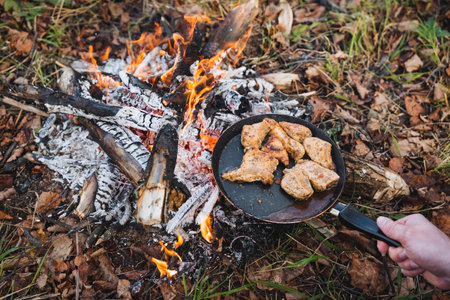Introduction to Family Camping and Crafting in the UK
Family camping has long been a cherished tradition across Britain, offering families a unique opportunity to reconnect with nature while escaping the bustle of everyday life. From the scenic Lake District to the rugged coasts of Cornwall, British campsites are filled with laughter, shared stories, and the simple pleasures of outdoor living. For many families, these trips become treasured annual rituals—moments when everyone can truly unwind together. However, beyond just enjoying the great outdoors, family camping also provides an excellent setting for children to engage in creative hands-on activities. In an age where screens often dominate leisure time, encouraging creativity through crafts not only entertains young campers but also nurtures vital skills like problem-solving and teamwork. Whether it’s fashioning leaf crowns, painting pebbles, or building miniature dens from twigs, crafting during camping helps children connect more deeply with their surroundings and each other. As we explore further, we’ll uncover why integrating creative crafts into family camping is such a rewarding part of the British camping experience.
Nature-Inspired Crafts Using Local Materials
One of the most memorable aspects of family camping in Britain is the chance to immerse children in nature and foster creativity through hands-on activities. British campsites are brimming with natural resources that can be transformed into delightful crafts. By encouraging children to collect materials such as pinecones, acorns, wildflowers, and smooth pebbles, you not only keep them engaged but also nurture an appreciation for the local environment.
Collecting Materials Responsibly
Before starting any craft activity, it’s important to teach children how to gather natural items with care and respect for wildlife. Encourage little ones to collect only what has fallen naturally rather than picking live plants or disturbing habitats. Many UK campsites have specific guidelines about foraging, so be sure to check local rules.
Common Natural Materials Found on British Campsites
| Material | Typical Location | Best Craft Uses |
|---|---|---|
| Pinecones | Beneath pine trees, woodland edges | Animal figures, bird feeders, ornaments |
| Acorns & Oak Leaves | Under oak trees, parkland areas | Necklaces, picture frames, collages |
| Smooth Pebbles | Lakesides, rivers, coastal areas | Pebble painting, story stones, game pieces |
| Wildflowers (fallen petals) | Meadows, grass verges (collect only loose petals) | Pressed flower bookmarks, greeting cards |
| Twigs & Sticks | Woodland floors, campsite perimeters | Miniature shelters, stick weaving, mobiles |
Clever Craft Ideas with Local Finds
Pinecones make excellent hedgehogs or owls by simply adding googly eyes and felt. Acorns and leaves can be threaded together for a seasonal garland or used to decorate picture frames made from twigs. Painted pebbles can become animals for storytelling games or even tic-tac-toe pieces. Pressed wildflowers turn into beautiful bookmarks—just place petals between the pages of a heavy book overnight. These simple yet engaging activities help children connect with the outdoors while creating lasting mementoes of their British camping adventure.

3. Upcycling Everyday Items into Fun Projects
Camping in Britain offers a brilliant opportunity to encourage children to think creatively about sustainability by transforming everyday waste into imaginative craft projects. Rather than discarding used packaging or picnic leftovers, families can collect items such as plastic bottles, tin cans, cardboard boxes, and even fabric scraps to upcycle them into new creations. This approach not only reduces rubbish but also teaches youngsters the importance of reusing resources while having fun together outdoors.
Turning Rubbish into Treasures
Children can be challenged to collect clean recyclable materials throughout the camping trip. For instance, an empty crisp packet could become shimmering bunting for the tent, or a used jam jar might be decorated with wildflowers and string to make a rustic lantern. These projects offer a hands-on way to discuss concepts like recycling and environmental responsibility, all within the relaxed setting of the British countryside.
Practical Craft Ideas from Camp Supplies
Get creative with what’s at hand: cardboard tubes from kitchen rolls can transform into binoculars for a woodland scavenger hunt, while plastic milk bottle tops are perfect for making colourful game pieces or counters. Old newspapers can be fashioned into papier-mâché creatures inspired by local wildlife. Each activity keeps little hands busy and sparks conversations about sustainable living—a theme increasingly important across UK communities.
Embracing British Resourcefulness
Upcycling during family camping doesn’t just foster environmental awareness; it also celebrates that classic British spirit of making do and mending. Children develop practical skills and pride in their handiwork, whether they’re crafting weatherproof signs for their campsite or inventing imaginative toys. Encouraging this mindful use of resources not only enriches the camping experience but helps nurture thoughtful habits that will serve them well long after the tents are packed away.
4. Traditional British Craft Activities for Kids
Britain is rich in craft traditions, many of which lend themselves beautifully to outdoor adaptation during family camping trips. By introducing children to these classic crafts, families not only foster creativity but also connect with cultural heritage in a hands-on and memorable way. Below are some traditional British crafts that can be simplified for children and easily managed at a campsite.
Morris Dancing Ribbons
Morris dancing is a well-known folk tradition across England. Children can create their own colourful ribbons using scraps of fabric or old clothes tied to sticks. This activity encourages movement and rhythm, allowing youngsters to dance around the campsite as part of their creative play.
Nature-Inspired Pottery
Inspired by the centuries-old British pottery tradition, children can use air-dry clay or natural mud to mould simple bowls or animal figures. Encourage them to decorate their creations with leaves, twigs, or small pebbles found nearby, making each piece unique and reflective of the local landscape.
Miniature Maypoles
The Maypole is a staple of British village festivals. At camp, kids can make mini maypoles using sturdy sticks and colourful string or yarn. Guide them in weaving the ribbons in patterns around the pole—a fun way to learn about this festive custom while improving dexterity.
Traditional Crafts Adapted for Outdoor Simplicity
| Craft Tradition | Outdoor Adaptation | Materials Needed |
|---|---|---|
| Corn Dolly Making | Create simple plaits with long grass or reeds found near the campsite. | Fresh grass/reeds, string (optional) |
| Pressed Flower Art | Press wildflowers between heavy books or stones, then glue onto card for nature bookmarks. | Wildflowers, card, glue, books/stones |
| Pebble Painting | Decorate smooth stones with paint or chalk, inspired by British seaside traditions. | Pebbles, water-based paint/chalks, brushes |
| Willow Weaving | Bend thin willow branches into basic wreath shapes for hanging on tents. | Willow branches (or bendy twigs), string (optional) |
Embracing Local Materials and Stories
Encourage children to gather materials responsibly from the environment around them—fallen leaves, feathers, wildflowers (where picking is permitted), and smooth stones. Accompany craft sessions with short stories about each tradition’s origin; for example, how corn dollies were made at harvest time for good luck or why pebble painting became popular along the British coast. This approach keeps crafts manageable while enriching the camping experience with meaningful context and connection to British culture.
5. Safety Tips and Parental Guidance
When it comes to creative crafts during family camping trips in Britain, safety should always come first. The great outdoors offers an inspiring backdrop for children’s imagination, but the unpredictability of British weather and the natural environment means parents need to be extra vigilant. Below, I’ll share practical advice for parents on how to safely supervise craft activities outside, ensuring a fun and secure experience for everyone involved.
Prepare for All Weather Conditions
British weather is famously changeable, so be sure to pack waterproofs, sun hats, and plenty of layers. Set up your crafting area under a gazebo or tarpaulin if possible, which can protect little hands from both drizzle and strong sunshine. Always check the forecast each morning and be ready to adapt your plans accordingly.
Choose Safe Materials
Opt for child-friendly scissors with blunt ends, non-toxic glues, and natural materials like sticks, leaves, and pebbles gathered under supervision. Avoid sharp tools or any items that could cause allergic reactions. If using paints or markers, ensure they are washable and suitable for outdoor use to minimise mess and skin irritation.
Supervise at All Times
Outdoors, distractions abound—so keep a close eye on children while they’re crafting. Assign specific roles if you’re camping with other families; one adult can oversee crafts while others manage cooking or tents. Encourage children to stay within the designated craft area to avoid wandering off into potentially unsafe surroundings.
Manage Clean-Up Responsibly
Teach children about leaving no trace by tidying up all craft materials after use. Bring resealable bags or containers for storing supplies and rubbish. This not only keeps wildlife safe but also reinforces respect for nature—a key part of the British camping ethos.
Be Ready for Emergencies
Always have a basic first aid kit on hand, including plasters, antiseptic wipes, and allergy medication if needed. Make sure you know the location of the nearest medical facilities at your campsite. Have a mobile phone charged in case you need to contact help quickly—signal may be patchy in some rural spots, so inform yourself about local emergency procedures before your trip.
By following these simple yet effective guidelines, parents can create a safe environment where children are free to explore their creativity amidst Britain’s beautiful—and sometimes unpredictable—countryside.
6. Making Memories: Sharing and Displaying Camp Creations
Once the crafts are finished, families have a wonderful opportunity to turn their campsite into a gallery of creativity. Setting up a small “exhibition” around the tent or caravan is an engaging way for children to showcase their handiwork. Consider using a string and some wooden pegs to hang painted stones, nature-inspired mobiles, or homemade bunting between trees. This not only brightens up the camping area but also gives every child a sense of pride in their work.
Family Craft Show-and-Tell
Organise a simple show-and-tell session one evening by the campfire. Each child can present their favourite creation, explaining what inspired them and how they made it. Encourage family members to ask questions or share stories about similar crafts they remember from their own childhoods. This tradition fosters communication and helps bridge generations through shared experience.
Photo Diaries and Scrapbooks
Capture photos of the children with their crafts in iconic British landscapes—whether it’s beside a Scottish loch, on a Cornish beach, or under the shade of an ancient oak in the Lake District. Later, these snapshots can be used to create family scrapbooks or digital albums, helping everyone relive those special moments long after the tents have been packed away.
Bringing the Outdoors Home
After returning home, proudly display the best creations on mantelpieces, windowsills, or as part of a seasonal nature table. Some families enjoy writing little labels describing where each craft was made and what local materials were used. Others might send handmade cards or painted pebbles as thoughtful gifts to grandparents or friends who couldn’t join the adventure.
Cherishing Traditions
The act of celebrating and displaying these crafts transforms simple activities into cherished traditions that families can look forward to year after year. Over time, these tangible reminders help weave a tapestry of shared experiences unique to each family’s British camping journeys.


